5.18 Case Study Conclusion: Cancer in the Family
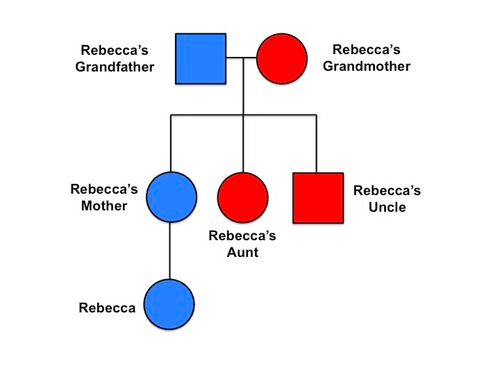
Case Study Conclusion: Cancer in the Family
Rebecca’s family tree, as illustrated in the pedigree above (Figure 5.18.1), shows a high incidence of cancer among close relatives. But are genes the cause of cancer in this family? Only genetic testing, which is the sequencing of specific genes in an individual, can reveal whether a cancer-causing gene is being inherited in this family.
Fortunately for Rebecca, the results of her genetic testing show that she does not have the mutations in the BRCA1 and BRCA2 genes that most commonly increase a person’s risk of getting cancer. This doesn’t mean, however, that she doesn’t have other mutations in these genes that could increase her risk of getting cancer. There are many other mutations in BRCA genes whose effect on cancer risk is still not known — and there may be many more yet to be discovered. Figure 5.18.2 from the National Cancer Institute illustrates many of the different types of known mutations in the BRCA1 gene. It is important to continue to study the variations in genes such as BRCA in different people to better assess their possible contribution to the development of disease. As you now know from this chapter, many mutations are harmless, while others can cause significant health effects, depending on the specific mutation and the gene involved.
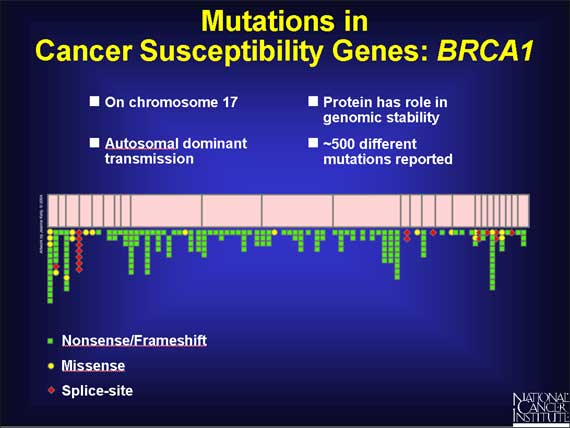
Mutations in BRCA genes are particularly likely to cause cancer because these genes encode for tumor-suppressor proteins that normally repair damaged DNA and control cell division. If these genes are mutated in a way that causes the proteins to not function properly, other mutations can accumulate and cell division can run out of control, which can cause cancer.
BRCA1 and BRCA2 are on chromosomes 17 and 13, respectively, which are autosomes. As Rebecca’s genetic counselor mentioned, mutations in these genes have a dominant inheritance pattern. Now that you know the pattern of inheritance of autosomal dominant genes, if Rebecca’s grandmother did have one copy of a mutated BRCA gene, what are the chances that Rebecca’s mother also has this mutation? Because it is dominant, only one copy of the gene is needed to increase the risk of cancer, and because it is on autosomes instead of sex chromosomes, the sex of the parent or offspring does not matter in the inheritance pattern. In this situation, Rebecca’s grandmother’s eggs would have had a 50 per cent chance of having a BRCA gene mutation (Mendel’s law of segregation). Therefore, Rebecca’s mother would have had a 50 per cent chance of inheriting this gene. Even though Rebecca does not have the most common BRCA mutations that increase the risk of cancer, it does not mean that her mother does not, because there would also only be a 50 per cent chance that she would pass it on to Rebecca. Rebecca’s mother, therefore, should consider getting tested for mutations in the BRCA genes, as well. Ideally, the individuals with cancer in a family should be tested first when a genetic cause is suspected, so that if there is a specific mutation being inherited, it can be identified, and the other family members can be tested for that same mutation.
Mutations in both BRCA1 and BRCA2 are often found in Ashkenazi Jewish families. However, these genes are not linked in the chromosomal sense, because they are on different chromosomes and are therefore inherited independently, in accordance with Mendel’s law of independent assortment. Why would certain gene mutations be prevalent in particular ethnic groups? If people within an ethnic group tend to produce offspring with each other, their genes will remain prevalent within the group. These may be genes for harmless variations such as skin, hair, or eye colour, or harmful variations such as the mutations in the BRCA genes. Other genetically based diseases and disorders are sometimes more commonly found in particular ethnic groups, such as cystic fibrosis in people of European descent, and sickle cell anemia in people of African descent. You will learn more about the prevalence of certain genes and traits in particular ethnic groups and populations in the chapter on Human Variation.
As you learned in this chapter, genetics is not the sole determinant of phenotype. The environment can also influence many traits, including adult height and skin colour. The environment plays a major role in the development of cancer, too. Ninety to 95 per cent of all cancers do not have an identified genetic cause, and are often caused by mutagens in the environment, such as UV radiation from the sun or toxic chemicals in cigarette smoke. But for families like Rebecca’s, knowing their family health history and genetic makeup may help them better prevent or treat diseases that are caused by their genetic inheritance. If a person knows they have a gene that can increase their risk of cancer, they can make lifestyle changes and have early and more frequent cancer screenings. They may even choose to have preventative surgeries that can help reduce their risk of getting cancer and increase their odds of long-term survival if cancer does occur. The next time you go to the doctor and they ask whether any members of your family have had cancer, you will have a deeper understanding why this information is so important to your health.
Chapter 5 Summary
In this chapter you learned about genetics — the science of heredity. Specifically you learned that:
- Chromosomes are structures made of DNA and proteins that are encoded with genetic instructions for making RNA and proteins. The instructions are organized into units called genes, which are segments of DNA that code for particular pieces of RNA. The RNA molecules can then act as a blueprint for proteins, or directly help regulate various cellular processes.
- Humans normally have 23 pairs of chromosomes. Of these, 22 pairs are autosomes, which contain genes for characteristics unrelated to sex. The other pair consists of sex chromosomes (XX in females, XY in males). Only the Y chromosome contains genes that determine sex.
- Humans have an estimated 20 thousand to 22 thousand genes. The majority of human genes have two or more possible versions, called alleles.
- Genes that are located on the same chromosome are called linked genes. Linkage explains why certain characteristics are frequently inherited together.
- Determining that DNA is the genetic material was an important milestone in biology.
-
- In the 1920s, Griffith showed that something in virulent bacteria could be transferred to nonvirulent bacteria, making them virulent, as well.
- In the 1940s, Avery and colleagues showed that the “something” Griffith found was DNA and not protein. This result was confirmed by Hershey and Chase, who demonstrated that viruses insert DNA into bacterial cells.
- In the 1950s, Chargaff showed that in DNA, the concentration of adenine is always the same as the concentration of thymine, and the concentration of guanine is always the same as the concentration of cytosine. These observations came to be known as Chargaff's rules.
- In the 1950s, James Watson and Francis Crick, building on the prior X-ray research of Rosalind Franklin and others, discovered the double helix structure of the DNA molecule.
- Knowledge of DNA’s structure helped scientists understand how DNA replicates, which must occur before cell division. DNA replication is semi-conservative because each daughter molecule contains one strand from the parent molecule and one new strand that is complementary to it.
- The central dogma of molecular biology can be summed up as: DNA → RNA → Protein. This means that the genetic instructions encoded in DNA are transcribed to RNA. From RNA, they are translated into a protein.
- RNA is a nucleic acid. Unlike DNA, RNA consists of just one polynucleotide chain instead of two, contains the base uracil instead of thymine, and contains the sugar ribose instead of deoxyribose.
- The main function of RNA is to help make proteins. There are three main types of RNA: messenger RNA (mRNA), ribosomal RNA (rRNA), and transfer RNA (tRNA).
- According to the RNA world hypothesis, RNA was the first type of biochemical molecule to evolve, predating both DNA and proteins.
- The genetic code was cracked in the 1960s by Marshall Nirenberg. It consists of the sequence of nitrogen bases in a polynucleotide chain of DNA or RNA. The four bases make up the “letters” of the code. The letters are combined in groups of three to form code “words,” or codons, each of which encodes for one amino acid or a start or stop signal.
-
- AUG is the start codon, and it establishes the reading frame of the code. After the start codon, the next three bases are read as the second codon, and so on until a stop codon is reached.
- The genetic code is universal, unambiguous, and redundant.
- Protein synthesis is the process in which cells make proteins. It occurs in two stages: transcription and translation.
-
- Transcription is the transfer of genetic instructions in DNA to mRNA in the nucleus. It includes the steps of initiation, elongation, and termination. After the mRNA is processed, it carries the instructions to a ribosome in the cytoplasm.
- Translation occurs at the ribosome, which consists of rRNA and proteins. In translation, the instructions in mRNA are read, and tRNA brings the correct sequence of amino acids to the ribosome. Then rRNA helps bonds form between the amino acids, producing a polypeptide chain.
- After a polypeptide chain is synthesized, it may undergo additional processing to form the finished protein.
- Mutations are random changes in the sequence of bases in DNA or RNA. They are the ultimate source of all new genetic variation in any species.
-
- Mutations may happen spontaneously during DNA replication or transcription. Other mutations are caused by environmental factors called mutagens.
- Germline mutations occur in gametes and may be passed on to offspring. Somatic mutations occur in cells other than gametes and cannot be passed on to offspring.
- Chromosomal alterations are mutations that change chromosome structure and usually affect the organism in multiple ways. Charcot-Marie-Tooth disease type 1 is an example of a chromosomal alteration.
- Point mutations are changes in a single nucleotide. The effects of point mutations depend on how they change the genetic code, and may range from no effects to very serious effects.
- Frameshift mutations change the reading frame of the genetic code and are likely to have a drastic effect on the encoded protein.
- Many mutations are neutral and have no effects on the organism in which they occur. Some mutations are beneficial and improve fitness, while others are harmful and decrease fitness.
- Using a gene to make a protein is called gene expression. Gene expression is regulated to ensure that the correct proteins are made when and where they are needed. Regulation may occur at any stage of protein synthesis or processing.
-
- The regulation of transcription is controlled by regulatory proteins that bind to regions of DNA called regulatory elements, which are usually located near promoters. Most regulatory proteins are either activators that promote transcription or repressors that impede transcription.
- A regulatory element common to almost all eukaryotic genes is the TATA box. A number of regulatory proteins must bind to the TATA box in the promoter before transcription can proceed.
- The regulation of gene expression is extremely important during the early development of an organism. Homeobox genes, which encode for chains of amino acids called homeodomains, are important genes that regulate development.
- Some types of cancer occur because of mutations in genes that control the cell cycle. Cancer-causing mutations most often occur in two types of regulatory genes, called tumor-suppressor genes and proto-oncogenes.
- Mendel experimented with the inheritance of traits in pea plants, which have two different forms of several visible characteristics. Mendel crossed pea plants with different forms of traits.
-
- In Mendel’s first set of experiments, he crossed plants that only differed in one characteristic. The results led to Mendel’s first law of inheritance, called the law of segregation. This law states that there are two factors controlling a given characteristic, one of which dominates the other, and these factors separate and go to different gametes when a parent reproduces.
- In Mendel’s second set of experiments, he experimented with two characteristics at a time. The results led to Mendel’s second law of inheritance, called the law of independent assortment. This law states that the factors controlling different characteristics are inherited independently of each other.
- Mendel’s laws of inheritance, now expressed in terms of genes, form the basis of genetics, the science of heredity. Mendel is often called the father of genetics.
- The position of a gene on a chromosome is its locus. A given gene may have different versions called alleles. Paired chromosomes of the same type are called homologous chromosomes and they have the same genes at the same loci.
- The alleles an individual inherits for a given gene make up the individual’s genotype. An organism with two of the same alleles is called a homozygote, and an individual with two different alleles is called a heterozygote.
- The expression of an organism’s genotype is referred to as its phenotype. A dominant allele is always expressed in the phenotype, even when just one dominant allele has been inherited. A recessive allele is expressed in the phenotype only when two recessive alleles have been inherited.
- In sexual reproduction, two parents produce gametes that unite in the process of fertilization to form a single-celled zygote. Gametes are haploid cells with only one of each pair of homologous chromosomes, and the zygote is a diploid cell with two of each pair of chromosomes.
- Meiosis is the type of cell division that produces four haploid daughter cells that may become gametes. Meiosis occurs in two stages, called meiosis I and meiosis II, each of which occurs in four phases (prophase, metaphase, anaphase, and telophase).
- Meiosis is followed by gametogenesis, the process in which the haploid daughter cells change into mature gametes. Males produce gametes called sperm through spermatogenesis, and females produce gametes called eggs through oogenesis.
- Sexual reproduction produces offspring that are genetically unique. Crossing-over, independent alignment, and the random union of gametes result in a high degree of genetic variation.
- Mendelian inheritance refers to the inheritance of traits controlled by a single gene with two alleles, one of which may be completely dominant to the other. The pattern of inheritance of Mendelian traits depends on whether the traits are controlled by genes on autosomes or by genes on sex chromosomes.
-
- Examples of human autosomal Mendelian traits include albinism and Huntington’s disease. Examples of human X-linked traits include red-green colour blindness and hemophilia.
- Two tools for studying inheritance are pedigrees and Punnett squares. A pedigree is a chart that shows how a trait is passed from generation to generation. A Punnett square is a chart that shows the expected ratios of possible genotypes in the offspring of two parents.
- Non-Mendelian inheritance refers to the inheritance of traits that have a more complex genetic basis than one gene with two alleles and complete dominance.
-
- Multiple allele traits are controlled by a single gene with more than two alleles. An example of a human multiple allele trait is ABO blood type.
- Codominance occurs when two alleles for a gene are expressed equally in the phenotype of heterozygotes. A human example of codominance occurs in the AB blood type, in which the A and B alleles are codominant.
- Incomplete dominance is the case in which the dominant allele for a gene is not completely dominant to a recessive allele, so an intermediate phenotype occurs in heterozygotes who inherit both alleles. A human example of incomplete dominance is Tay Sachs disease, in which heterozygotes produce half as much functional enzyme as normal homozygotes.
- Polygenic traits are controlled by more than one gene, each of which has a minor additive effect on the phenotype. This results in a continuum of phenotypes. Examples of human polygenic traits include skin colour and adult height. Many of these types of traits, as well as others, are affected by the environment, as well as by genes.
- Pleiotropy refers to the situation in which a gene affects more than one phenotypic trait. A human example of pleiotropy occurs with sickle cell anemia, which has multiple effects on the body.
- Epistasis is when one gene affects the expression of other genes. An example of epistasis is albinism, in which the albinism mutation negates the expression of skin colour genes.
- Genetic disorders are diseases, syndromes, or other abnormal conditions that are caused by mutations in one or more genes or by chromosomal alterations.
-
- Examples of genetic disorders caused by single-gene mutations include Marfan syndrome (autosomal dominant), sickle cell anemia (autosomal recessive), vitamin D-resistant rickets (X-linked dominant), and hemophilia A (X-linked recessive). Very few genetic disorders are caused by dominant mutations because these alleles are less likely to be passed on to successive generations.
- Nondisjunction is the failure of replicated chromosomes to separate properly during meiosis. This may result in genetic disorders caused by abnormal numbers of chromosomes. An example is Down syndrome, in which the individual inherits an extra copy of chromosome 21. Most chromosomal disorders involve the X chromosome. An example is Klinefelter’s syndrome (XXY, XXXY).
- Prenatal genetic testing (by amniocentesis, for example) can detect chromosomal alterations in utero. The symptoms of some genetic disorders can be treated or prevented. For example, symptoms of phenylketonuria (PKU) can be prevented by following a low-phenylalanine diet throughout life.
- Cures for genetic disorders are still in the early stages of development. One potential cure is gene therapy, in which normal genes are introduced into cells by a vector such as a virus to compensate for mutated genes.
- Genetic engineering is the use of technology to change the genetic makeup of living things for human purposes.
-
- Genetic engineering methods include gene cloning and the polymerase chain reaction. Gene cloning is the process of isolating and making copies of a DNA segment, such as a gene. The polymerase chain reaction makes many copies of a gene or other DNA segment.
- Genetic engineering can be used to transform bacteria so they are able to make human proteins, such as insulin. It can also be used to create transgenic crops, such as crops that yield more food or resist insect pests.
- Genetic engineering has raised a number of ethical, legal, and social issues including health, environmental, and privacy concerns.
- The human genome refers to all of the DNA of the human species. It consists of more than 3.3 billion base pairs divided into 20,500 genes on 23 pairs of chromosomes.
- The Human Genome Project (HGP) was a multi-billion dollar international research project that began in 1990. By 2003, it had sequenced and mapped the location of all of the DNA base pairs in the human genome. It published the results as a human reference genome that is available to anyone on the Internet.
- Sequencing of the human genome is helping researchers better understand cancer and genetic diseases. It is also helping them tailor medications to individual patients, which is the focus of the new field of pharmacogenomics. In addition, it is helping researchers better understand human evolution.
Chapter 5 Review
-
- What are the differences between a sequence of DNA and the sequence of mature mRNA that it produces?
- Scientists sometimes sequence DNA that they “reverse transcribe” from the mRNA in an organism’s cells, which is called complementary DNA (cDNA). Why do you think this technique might be particularly useful for understanding an organism’s proteins versus sequencing the whole genome (i.e. nuclear DNA) of the organism?
- A person has a hypothetical A a genotype. Answer the following questions about this genotype:
- What do A and a represent?
- If the person expresses only the phenotype associated with A, is this an example of complete dominance, codominance, or incomplete dominance? Explain your answer. Also, describe what the observed phenotypes would be if it were either of the two incorrect answers.
- Explain how a mutation that occurs in a parent can result in a genetic disorder in their child. Be sure to include which type of cell or cells in the parent must be affected in order for this to happen.
- What is the term for an allele that is not expressed in a heterozygote?
- What might happen if codons encoded for more than one amino acid?
- Explain why a human gene can be inserted into bacteria and can still produce the correct human protein, despite being in a very different organism.
- What is gene therapy? Why is gene therapy considered a type of biotechnology?
Chapter 5 Attributions and References
Unit 5.18 Image Attributions
- Figure 5.18.1 Rebeccas Pedigree Cancer by CK-12 Foundation is used under a CC BY 3.0 (https://creativecommons.org/licenses/by/3.0/) license.
 ©CK-12 Foundation Licensed under
©CK-12 Foundation Licensed under  • Terms of Use • Attribution
• Terms of Use • Attribution
- Figure 5.18.2 Mutations_on_BRCA1 by National Cancer Institute (NCI) on Wikimedia Commons is in the public domain (https://en.wikipedia.org/wiki/Public_domain).
Reference
Brainard, J/ CK-12 Foundation. (2016). Figure 1 Pedigree for Rebecca’s family, as described in the beginning of this chapter, [digital image]. In CK-12 College Human Biology (Section 5.17) [online Flexbook]. CK12.org. https://www.ck12.org/book/ck-12-college-human-biology/section/5.17/
The front lobe of the pituitary gland that synthesizes and secretes pituitary hormones.
A group of diseases involving abnormal cell growth with the potential to invade or spread to other parts of the body.
A sequence of nucleotides in DNA or RNA that codes for a molecule that has a function.
A molecule that can undergo polymerization, creating macromolecules. Large numbers of monomers combine to form polymers in a process called polymerization.
A testable proposed explanation for a phenomenon.
A threadlike structure of nucleic acids and protein found in the nucleus of most living cells, carrying genetic information in the form of genes.
A class of biological molecule consisting of linked monomers of amino acids and which are the most versatile macromolecules in living systems and serve crucial functions in essentially all biological processes.
Image shows an illustration of a bunion, in which the bones at the base of the big toe start to shift outward from the foot, causing a large outward bump, and the angling of the big toe towards the other toes.
A variant form of a given gene, meaning it is one of two or more versions of a known mutation at the same place on a chromosome. It can also refer to different sequence variations for a several-hundred base-pair or more region of the genome that codes for a protein.
An explanation of an aspect of the natural world that can be repeatedly tested and verified in accordance with the scientific method.
The evolutionary development and history of a species or trait of a species or of a higher taxonomic grouping of organisms.
The process by which a parent cell divides into two or more daughter cells. Cell division usually occurs as part of a larger cell cycle.
The process by which DNA is copied.
A scientific law is a statement based on repeated experimental observations that describes some aspect of the world.
A complex organic substance present in living cells, especially DNA or RNA, whose molecules consist of many nucleotides linked in a long chain.
A biomolecule consisting of carbon (C), hydrogen (H) and oxygen (O) atoms, usually with a hydrogen–oxygen atom ratio of 2:1. Complex carbohydrates are polymers made from monomers of simple carbohydrates, also termed monosaccharides.
Created by CK-12 Foundation/Adapted by Christine Miller

Marvelous Muscles
Does the word muscle make you think of the well-developed muscles of a weightlifter, like the woman in Figure 12.2.1? Her name is Natalia Zabolotnaya, and she’s a Russian Olympian. The muscles that are used to lift weights are easy to feel and see, but they aren’t the only muscles in the human body. Many muscles are deep within the body, where they form the walls of internal organs and other structures. You can flex your biceps at will, but you can’t control internal muscles like these. It’s a good thing that these internal muscles work without any conscious effort on your part, because movement of these muscles is essential for survival. Muscles are the organs of the muscular system.
What Is the Muscular System?
The muscular system consists of all the muscles of the body. The largest percentage of muscles in the muscular system consists of skeletal muscles, which are attached to bones and enable voluntary body movements (shown in Figure 12.2.2). There are almost 650 skeletal muscles in the human body, many of them shown in Figure 12.2.2. Besides skeletal muscles, the muscular system also includes cardiac muscle, which makes up the walls of the heart, and smooth muscles, which control movement in other internal organs and structures.
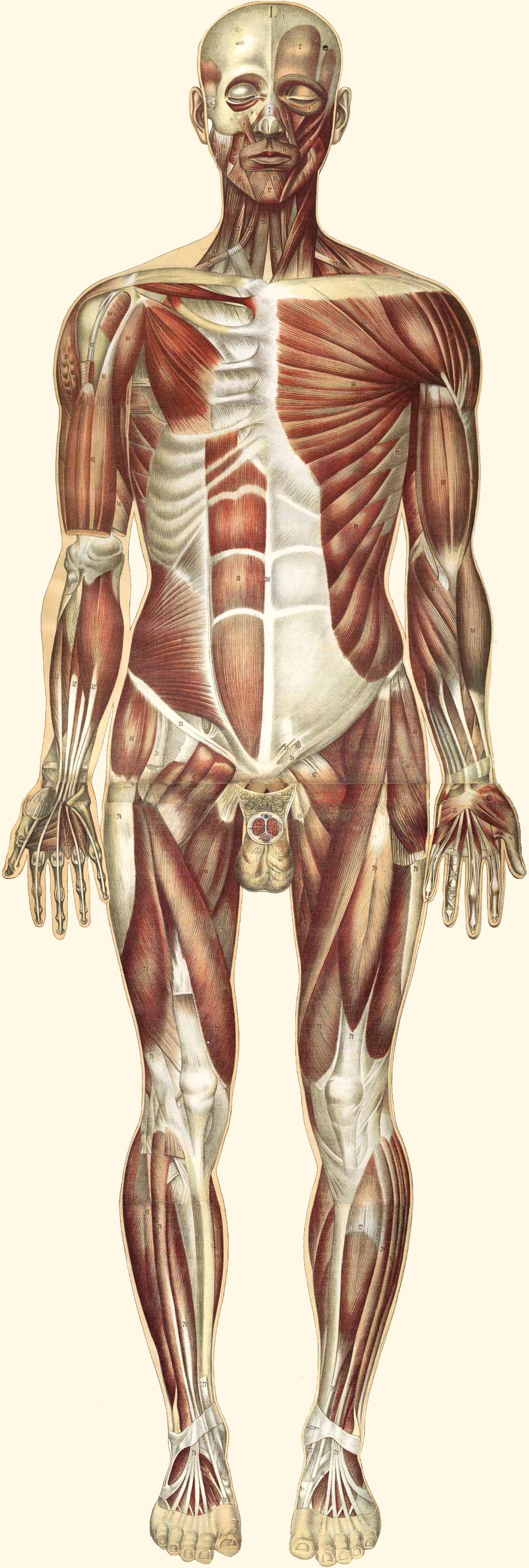
Muscle Structure and Function
Muscles are organs composed mainly of muscle cells, which are also called muscle fibres (mainly in skeletal and cardiac muscle) or myocytes (mainly in smooth muscle). Muscle cells are long, thin cells that are specialized for the function of contracting. They contain protein filaments that slide over one another using energy in ATP. The sliding filaments increase the tension in — or shorten the length of — muscle cells, causing a contraction. Muscle contractions are responsible for virtually all the movements of the body, both inside and out.
Skeletal muscles are attached to bones of the skeleton. When these muscles contract, they move the body. They allow us to use our limbs in a variety of ways, from walking to turning cartwheels. Skeletal muscles also maintain posture and help us to keep balance.
Smooth muscles in the walls of blood vessels contract to cause vasoconstriction, which may help conserve body heat. Relaxation of these muscles causes vasodilation, which may help the body lose heat. In the organs of the digestive system, smooth muscles squeeze food through the gastrointestinal tract by contracting in sequence to form a wave of muscle contractions called peristalsis. Think of squirting toothpaste through a tube by applying pressure in sequence from the bottom of the tube to the top, and you have a good idea of how food is moved by muscles through the digestive system. Peristalsis of smooth muscles also moves urine through the urinary tract.
Cardiac muscle tissue is found only in the walls of the heart. When cardiac muscle contracts, it makes the heart beat. The pumping action of the beating heart keeps blood flowing through the cardiovascular system.
Muscle Hypertrophy and Atrophy
Muscles can grow larger, or hypertrophy. This generally occurs through increased use, although hormonal or other influences can also play a role. The increase in testosterone that occurs in males during puberty, for example, causes a significant increase in muscle size. Physical exercise that involves weight bearing or resistance training can increase the size of skeletal muscles in virtually everyone. Exercises (such as running) that increase the heart rate may also increase the size and strength of cardiac muscle. The size of muscle, in turn, is the main determinant of muscle strength, which may be measured by the amount of force a muscle can exert.
Muscles can also grow smaller, or atrophy, which can occur through lack of physical activity or from starvation. People who are immobilized for any length of time — for example, because of a broken bone or surgery — lose muscle mass relatively quickly. People in concentration or famine camps may be so malnourished that they lose much of their muscle mass, becoming almost literally just “skin and bones.” Astronauts on the International Space Station may also lose significant muscle mass because of weightlessness in space (see Figure 12.2.3).
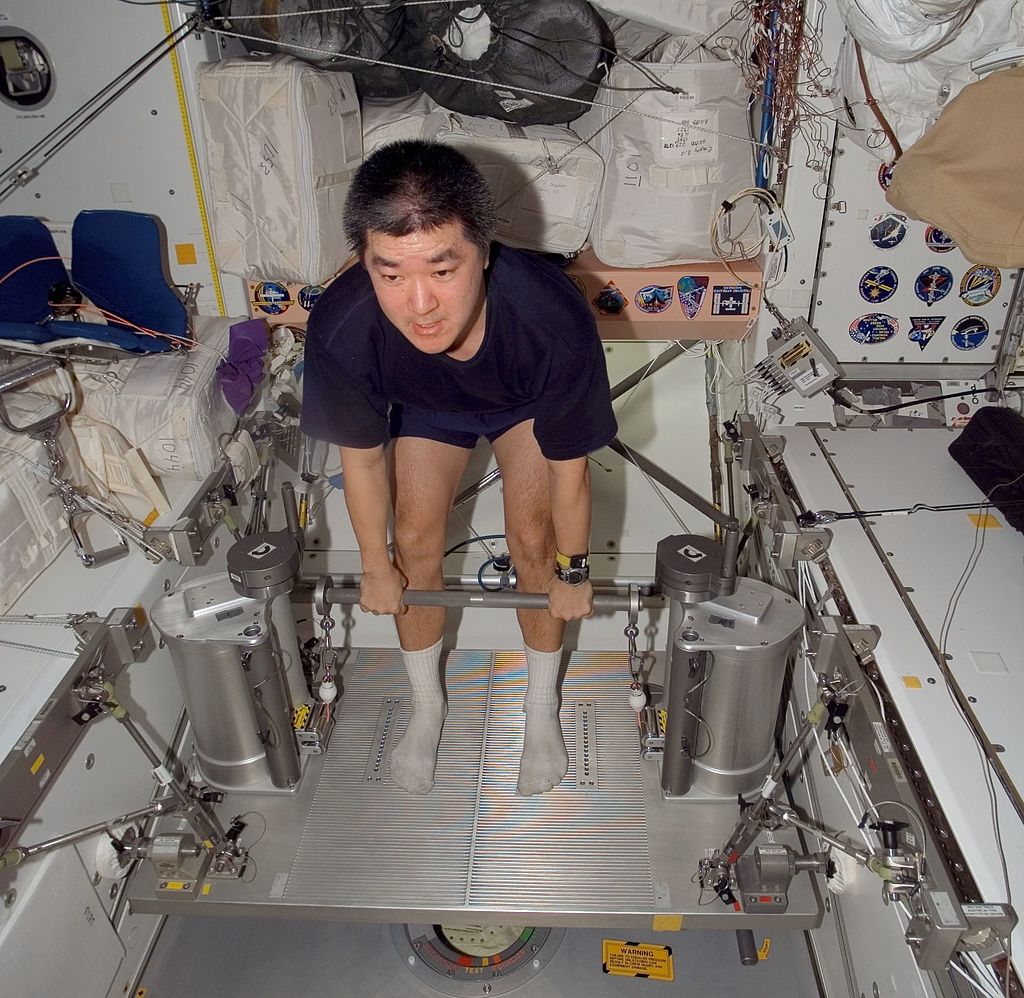
Many diseases, including cancer and AIDS, are often associated with muscle atrophy. Atrophy of muscles also happens with age. As people grow older, there is a gradual decrease in the ability to maintain skeletal muscle mass, known as sarcopenia. The exact cause of sarcopenia is not known, but one possible cause is a decrease in sensitivity to growth factors that are needed to maintain muscle mass. Because muscle size determines strength, muscle atrophy causes a corresponding decline in muscle strength.
In both hypertrophy and atrophy, the number of muscle fibres does not change. What changes is the size of the muscle fibres. When muscles hypertrophy, the individual fibres become wider. When muscles atrophy, the fibres become narrower.
Interactions with Other Body Systems
Muscles cannot contract on their own. Skeletal muscles need stimulation from motor neurons in order to contract. The point where a motor neuron attaches to a muscle is called a neuromuscular junction. Let’s say you decide to raise your hand in class. Your brain sends electrical messages through motor neurons to your arm and shoulder. The motor neurons, in turn, stimulate muscle fibres in your arm and shoulder to contract, causing your arm to rise.
Involuntary contractions of smooth and cardiac muscles are also controlled by electrical impulses, but in the case of these muscles, the impulses come from the autonomic nervous system (smooth muscle) or specialized cells in the heart (cardiac muscle). Hormones and some other factors also influence involuntary contractions of cardiac and smooth muscles. For example, the fight-or-flight hormone adrenaline increases the rate at which cardiac muscle contracts, thereby speeding up the heartbeat.
Muscles cannot move the body on their own. They need the skeletal system to act upon. The two systems together are often referred to as the musculoskeletal system. Skeletal muscles are attached to the skeleton by tough connective tissues called tendons. Many skeletal muscles are attached to the ends of bones that meet at a joint. The muscles span the joint and connect the bones. When the muscles contract, they pull on the bones, causing them to move. The skeletal system provides a system of levers that allow body movement. The muscular system provides the force that moves the levers.
12.2 Summary
- The muscular system consists of all the muscles of the body. There are three types of muscle: skeletal muscle (which is attached to bones and enables voluntary body movements), cardiac muscle (which makes up the walls of the heart and makes it beat), and smooth muscle (which is found in the walls of internal organs and other internal structures and controls their movements).
- Muscles are organs composed mainly of muscle cells, which may also be called muscle fibres or myocytes. Muscle cells are specialized for the function of contracting, which occurs when protein filaments inside the cells slide over one another using energy in ATP.
- Muscles can grow larger, or hypertrophy. This generally occurs through increased use (physical exercise), although hormonal or other influences can also play a role. Muscles can also grow smaller, or atrophy. This may occur through lack of use, starvation, certain diseases, or aging. In both hypertrophy and atrophy, the size — but not the number — of muscle fibres changes. The size of muscles is the main determinant of muscle strength.
- Skeletal muscles need the stimulus of motor neurons to contract, and to move the body, they need the skeletal system to act upon. Involuntary contractions of cardiac and smooth muscles are controlled by special cells in the heart, nerves of the autonomic nervous system, hormones, or other factors.
12.2 Review Questions
- What is the muscular system?
- Describe muscle cells and their function.
- Identify three types of muscle tissue and where each type is found.
- Define muscle hypertrophy and muscle atrophy.
- What are some possible causes of muscle hypertrophy?
- Give three reasons that muscle atrophy may occur.
- How do muscles change when they increase or decrease in size?
- How do changes in muscle size affect strength?
- Explain why astronauts can easily lose muscle mass in space.
- Describe how the terms muscle cells, muscle fibres, and myocytes relate to each other.
-
- Name two systems in the body that work together with the muscular system to carry out movements.
- Describe one way in which the muscular system is involved in regulating body temperature.
12.2 Explore More
https://www.youtube.com/watch?v=VVL-8zr2hk4
How your muscular system works - Emma Bryce, TED-Ed, 2017.
https://www.youtube.com/watch?v=Ujr0UAbyPS4&feature=emb_logo
3D Medical Animation - Peristalsis in Large Intestine/Bowel || ABP ©, AnimatedBiomedical, 2013.
https://www.youtube.com/watch?v=LkXwfTsqQgQ&feature=emb_logo
Muscle matters: Dr Brendan Egan at TEDxUCD, TEDx Talks, 2014.
Attributions
Figure 12.2.1
Natalia_Zabolotnaya_2012b by Simon Q on Wikimedia Commons is used under a CC BY 2.0 (https://creativecommons.org/licenses/by/2.0/deed.en) license.
Figure 12.2.2
Bougle_whole2_retouched by Bouglé, Julien from the National LIbrary of Medicine (NLM) on Wikimedia Commons is in the public domain (https://en.wikipedia.org/wiki/Public_domain).
Figure 12.2.3
Daniel_Tani_iss016e027910 by NASA/ International Space Station Imagery on Wikimedia Commons is in the public domain (https://en.wikipedia.org/wiki/Public_domain).
References
AnimatedBiomedical. (2013, January 30). 3D Medical animation - Peristalsis in large intestine/bowel || ABP ©. YouTube. https://www.youtube.com/watch?v=Ujr0UAbyPS4&feature=youtu.be
Bouglé, J. (1899). Le corps humain en grandeur naturelle : planches coloriées et superposées, avec texte explicatif. J. B. Baillière et fils. In Historical Anatomies on the Web. http://www.nlm.nih.gov/exhibition/historicalanatomies/bougle_home.html
TED-Ed. (2017, October 26). How your muscular system works - Emma Bryce. YouTube. https://www.youtube.com/watch?v=VVL-8zr2hk4&feature=youtu.be
TEDx Talks. (2014, June 27). Muscle matters: Dr Brendan Egan at TEDxUCD. YouTube. https://www.youtube.com/watch?v=LkXwfTsqQgQ&feature=youtu.be
Wikipedia contributors. (2020, June 15). Natalya Zabolotnaya. In Wikipedia. https://en.wikipedia.org/w/index.php?title=Natalya_Zabolotnaya&oldid=962630409
An antibody, also known as an immunoglobulin, is a large, Y-shaped protein produced mainly by plasma cells that is used by the immune system to neutralize pathogens such as pathogenic bacteria and viruses.
A sequence of 3 DNA or RNA nucleotides that corresponds with a specific amino acid or stop signal during protein synthesis.
Amino acids are organic compounds that combine to form proteins.
The specific location in DNA where a set of codons will code for a certain protein. The reading frame begins with the start codon (AUG).
Image shows a labelled diagram highlighting the location of the uterus in pregnancy. The developing fetus, amniotic fluid and placenta are all housed in the uterus, which stretches to many times its regular size to accommodate pregnancy.
Attracted to water.
Mutation in cells destined to become egg or sperm cells. These mutations can be passed to offspring.
Mutations acquired by a cell that can be passed to future cells arising from the mutated cell in the course of cell division.
A force that acts between the protons and neutrons of atoms.
A force that acts between the protons and neutrons of atoms.
Created by CK-12 Foundation/Adapted by Christine Miller

Case Study: Cough That Won't Quit
Three weeks ago, 20-year-old Erica came down with symptoms typical of the common cold. She had a runny nose, fatigue, and a mild cough. Her symptoms were starting to improve, but recently, her cough has been getting worse. She is coughing up a lot of thick mucus, her throat is sore from frequent coughing, and her chest feels very congested. According to her grandmother, Erica has a “chest cold.” Erica is a smoker and wonders if her habit is making her cough worse. She decides that it's time to see a doctor.
Dr. Choo examines Erica and asks about her symptoms and health history. She checks the level of oxygen in Erica’s blood by attaching a device called a pulse oximeter to Erica’s finger.

Dr. Choo concludes that Erica has bronchitis, which is an infection that commonly occurs after a person has a cold or flu. Bronchitis is sometimes referred to as a “chest cold,” so Erica’s grandmother was right! Bronchitis causes inflammation and a build up of mucus in the bronchial tubes in the chest.
Because bronchitis is usually caused by viruses and not bacteria, Dr. Choo tells Erica that antibiotics are not likely to help. Instead, she recommends that Erica try to thin out and remove the mucus by drinking plenty of fluids and using a humidifier or spending time in a steamy shower. She recommends that Erica get plenty of rest as well.
Dr. Choo also tells Erica some things not to do — most importantly, to stop smoking while she is sick, and to try to quit smoking in the long-term. She explains that smoking can make people more susceptible to bronchitis and can hinder recovery. Finally, she advises Erica to avoid taking over-the-counter cough suppressant medication.
As you read this chapter about the respiratory system, you will be able to better understand what bronchitis is, and why Dr. Choo made the treatment recommendations that she did. At the end of the chapter, you will learn more about acute bronchitis, which is the type that Erica has. This information may come in handy to you personally, because chances are high that you will get this common infection at some point in your life — there are millions of cases of bronchitis every year!
Chapter Overview: Respiratory System
In this chapter, you will learn about the respiratory system — the system that exchanges gases (such as oxygen and carbon dioxide) between the body and the outside air. Specifically, you will learn about:
- The process of respiration, in which oxygen moves from the outside air into the body and carbon dioxide and other waste gases move from inside the body into the outside air.
- The organs of the respiratory system, including the lungs, bronchial tubes, and the rest of the respiratory tract.
- How the respiratory tract protects itself from pathogens and other potentially harmful substances in the air.
- How the rate of breathing is regulated to maintain homeostasis of blood gases and pH.
- How ventilation, or breathing, allows us to inhale air into the body and exhale air out of the body.
- The conscious and unconscious control of breathing.
- Nasal breathing compared to mouth breathing.
- What happens when a person is drowning.
- How gas exchange occurs between the air and blood in the alveoli of the lungs, and between the blood and cells throughout the body.
- Disorders of the respiratory system, including asthma, pneumonia, chronic obstructive pulmonary disease (COPD), and lung cancer.
- The negative health effects of smoking.
As you read the chapter, think about the following questions:
- Where are the bronchial tubes? What is their function?
- What is the function of mucus? Why can too much mucus be a bad thing?
- Why did Dr. Choo check Erica’s blood oxygen level?
- Why do you think Dr. Choo warned Erica to avoid cough suppressant medications?
- How does acute bronchitis compare to chronic bronchitis? How do they both relate to smoking?
Attributions
Figure 13.1.1
Cold/ Look into my eyes forever [photo] by Spencer Backman on Unsplash is used under the Unsplash License (https://unsplash.com/license).
Figure 13.1.2
Wrist-oximeter by UusiAjaja on Wikimedia Commons is used under a CC0 1.0 Universal Public Domain Dedication (https://creativecommons.org/publicdomain/zero/1.0/deed.en) license.
Reference
Mayo Clinic Staff. (n.d.). Bronchitis [online article]. Mayoclinic.org. https://www.mayoclinic.org/diseases-conditions/bronchitis/symptoms-causes/syc-20355566
The process by which information from a gene is used in the synthesis of a functional protein.
A central organelle containing hereditary material.
A microorganism which causes disease.
A tree diagram used to show the hypothesized evolutionary relationships between groups of organisms.
A large molecule, or macromolecule, composed of many repeated subunits.
As per caption.
A cycle of growth and division that cells go through. It includes interphase (G1, S, and G2) and the mitotic phase.
The outermost part of the hair shaft. It is formed from dead cells, overlapping in layers, which form scales that strengthen and protect the hair shaft.
A part of a hair that is visible above the surface of the skin and consists of dead keratinocytes.
The lower layer of the dermis that gives the dermis strength and elasticity and contains many dermal structures such as glands and hair follicles.
Two pieces of DNA within a diploid organism which carry the same types genes, one from each parental source.
The part of the genetic makeup of a cell, and therefore of any individual, which determines one of its characteristics (phenotype).
Any gland of the endocrine system, which is the system of glands that releases hormones directly into the blood.
Any gland of the endocrine system, which is the system of glands that releases hormones directly into the blood.
Body cavity that fills the lower half of the trunk and holds the kidneys and the digestive and reproductive organs.
Refers to the relationship between two versions of a gene. Individuals receive two versions of each gene, known as alleles, from each parent. If the alleles of a gene are different, one allele will be expressed; it is the dominant gene. The effect of the other allele, called recessive, is masked.
Body cavity that fills the lower half of the trunk and holds the kidneys and the digestive and reproductive organs.
Image shows a diagram of nervous control of respiration. The medulla and pons will signal the rate at which the diaphragm and intercostal muscles should initiate breathing.
A mature haploid male or female germ cell which is able to unite with another of the opposite sex in sexual reproduction to form a zygote.
The fusion of haploid gametes, egg and sperm, to form the diploid zygote.
Image shows to small children in a backyard wading pool. One adult is standing by the pool resting their foot on the edge and another adult is sitting nearby in a lawn chair.
Image shows a man at an oxygen bar. There are several erlenmeyer flasks of differently scented oxygen with tubes coming out of the top of each. The man is wearing a nasal cannula (tube that blows air into your nostrils).
A type of immune cell that has granules (small particles) with enzymes that are released during allergic reactions and asthma. A basophil is a type of white blood cell and a type of granulocyte.
A genetically-based trait that has evolved because it helps living things survive and reproduce in a given environment.
The process whereby a haploid cell (n) is formed from a diploid cell (2n) through meiosis and cell differentiation. Gametogenesis in the male is known as spermatogenesis and produces spermatozoa. Gametogenesis in the female is known as oogenesis and result in the formation of ova.
A biological process which converts sugars such as glucose, fructose, and sucrose into cellular energy, producing ethanol and carbon dioxide as by-products.
The main mineralocorticoid hormone which is responsible for sodium conservation in the kidney, salivary glands, sweat glands and colon.
A non-steroid catecholamine hormone produced by the medulla of the adrenal glands that stimulates the fight-or-flight response.
The process of producing cellular energy involving oxygen. Cells break down food in the mitochondria in a long, multi-step process that produces roughly 36 ATP. The first step in is glycolysis, the second is the Krebs cycle and the third is the electron transport system.
The study of the structure of the body.
Image shows a diagram comparison of healthy alveoli and alveoli with COPD/Emphysema. The healthy alveoli are individual small spheres and the alveoli with emphysema have merged through breakdown of the walls and instead of many small chambers for air, there are fused larger chambers, reducing the surface area.
Created by CK-12 Foundation/Adapted by Christine Miller
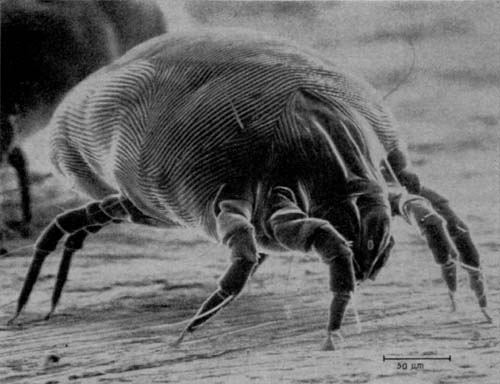
A “Mitey” Monster
The scary beast in Figure 13.5.1 is likely to be lurking in your own home, where it feeds on organic debris, including human skin. What is it? It’s the common dust mite, a close relative of spiders. The dust mite is so small that it is barely visible with the unaided eye, so it’s obviously shown greatly enlarged above. If you think you can get rid of dust mites in your home by frequent and thorough cleaning, think again. There may be thousands of dust mites in just one gram of dust! Regardless of how clean you keep your house, you can't eliminate dust mites entirely. So why even bother trying? The feces of dust mites contain proteins that are a common trigger of asthma attacks.
Asthma
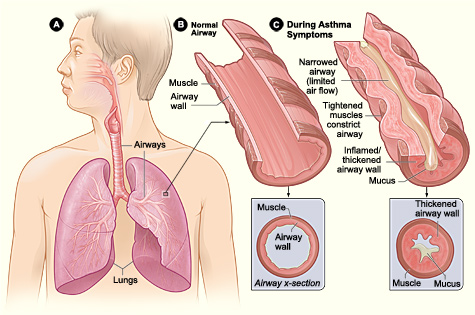
Asthma is a chronic inflammatory disease of the airways in the lungs, in which the airways periodically become inflamed. As you can see in Figure 13.5.2, this causes swelling and narrowing of the airways, often accompanied by excessive mucus production. Symptoms of asthma include difficulty breathing, coughing, wheezing, shortness of breath, and chest tightness. Some people with asthma rarely experience symptoms, and then usually only in response to certain triggers in the environment. Other people may have symptoms almost all of the time.
Asthma is thought to be caused by a combination of genetic and environmental factors. A person with a family history of asthma is more likely to develop the disease. Dozens of genes have been found to be associated with asthma, many of which are related to the immune system. Additional risk factors include obesity and sleep apnea. Environmental factors trigger asthma attacks in people who have a genetic predisposition to the disease. Besides dust mite feces, triggers may include other allergens (such as pet dander, cockroaches, and mold), certain medications including aspirin, air pollution, and stress. Symptoms tend to be worse at night and early in the morning. They may also worsen during upper respiratory tract infections, strenuous exercise, or when the airways are exposed to cold air.
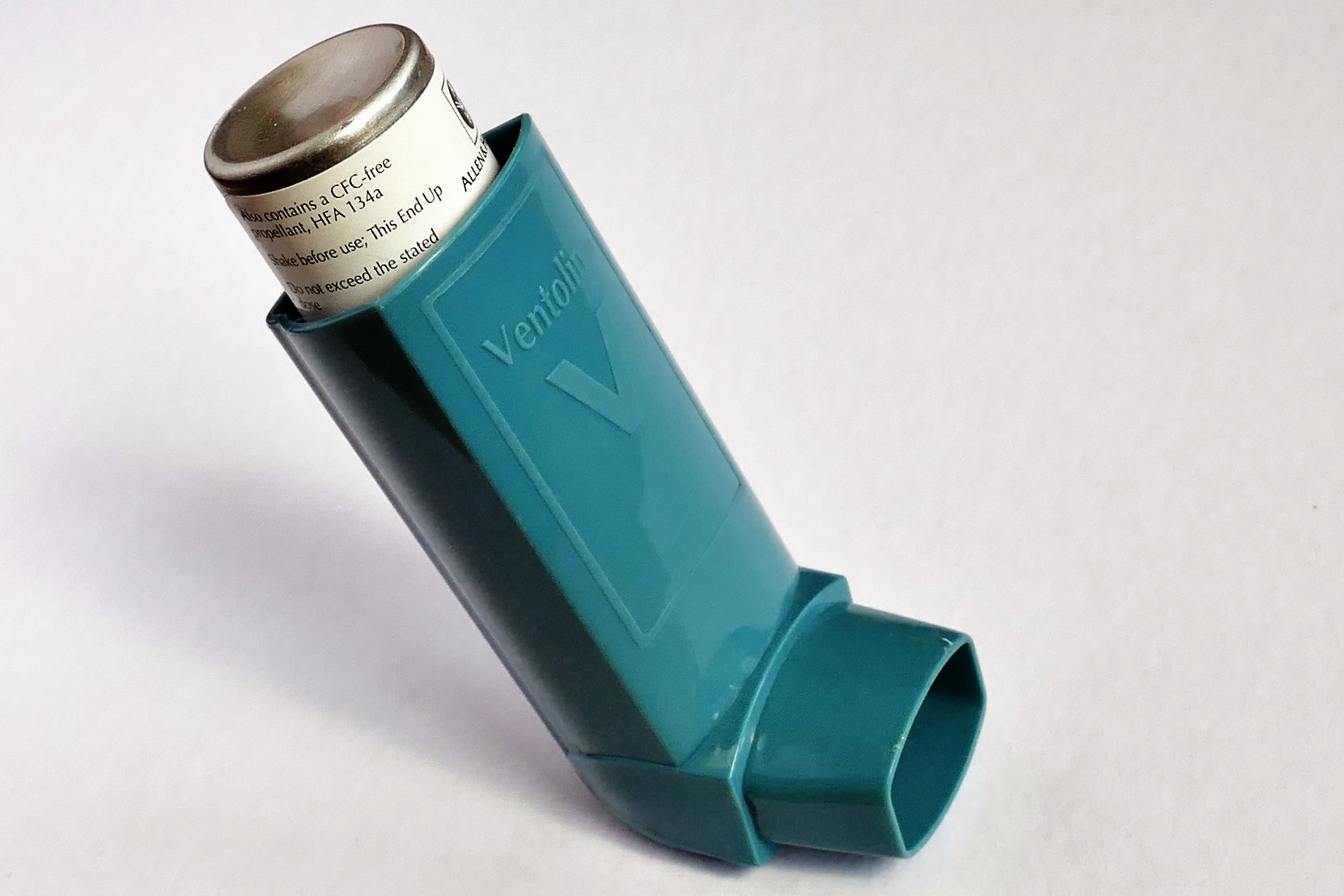
There is no cure for asthma at present, but the symptoms of asthma attacks usually can be reversed with the use of inhaled medications called bronchodilators (as shown in Figure 13.5.3). These medications soothe the constricted air passages and help to re-expand them, making breathing easier. The medications usually start to take effect almost immediately. Other medications can be taken for long-term control of the disease. These medications help prevent asthma attacks from occurring. Corticosteroids are generally considered the most effective treatment for long-term control. Another way to prevent asthma attacks is by avoiding triggers whenever possible.
Pneumonia
Another common inflammatory disease of the respiratory tract is pneumonia. In pneumonia, inflammation affects primarily the alveoli, which are the tiny air sacs of the lungs. Inflammation causes some of the alveoli to become filled with fluid so that gas exchange cannot occur, as you can see illustrated in Figure 13.5.4. Symptoms of pneumonia typically include coughing, chest pain, difficulty breathing, and fever.

Pneumonia often develops as a consequence of an upper respiratory tract infection (such as the common cold or flu), especially in the very young and the elderly. It is usually caused by bacteria or viruses, although some cases may be caused by other microorganisms, such as fungi. The majority of cases are caused by just a few pathogens, the most common being the bacterium Streptococcus pneumoniae. Pneumonia is more likely to develop in people who have other lung diseases, such as asthma, a history of smoking, heart failure, or a weakened immune system.
Vaccines are available to prevent certain types of bacterial and viral pneumonia, including pneumonia caused by Streptococcus pneumoniae. Treatment of pneumonia depends on the cause. For example, if the disease is caused by bacteria, antibiotics are generally prescribed. In cases of severe pneumonia, hospitalization and supplemental oxygen may be required.
Chronic Obstructive Pulmonary Disease
Chronic obstructive pulmonary disease (COPD) is a lung disease characterized by chronic poor airflow due to increasing in-elasticity of lung tissue and breakdown of the walls of the alveoli. The main symptoms include shortness of breath and a cough that produces phlegm. These symptoms are usually present for a long period of time, and typically become worse over time. Eventually, walking up stairs and similar activities become difficult because of shortness of breath.
COPD formerly was referred to as chronic bronchitis or emphysema. Now, the term chronic bronchitis is used to refer to the symptoms of COPD, and the term emphysema is used to refer to the lung changes that occur with COPD. Some of these lung changes are shown in Figure 13.5.5 below. They include a breakdown of connective tissues that reduces the number and elasticity of alveoli. As a result, the patient can no longer fully exhale air from the lungs, so air becomes trapped in the lungs. Gas exchange is hampered and may lead to low oxygen levels, as well as too much carbon dioxide in the blood.
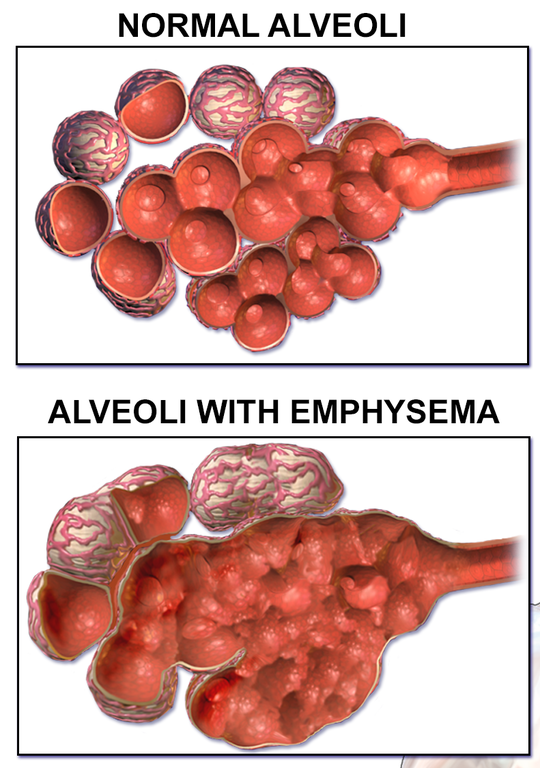
Smoking tobacco and vaping are the major cause of COPD, with a number of other factors such as air pollution and genetics playing smaller roles. Of people who are life-long smokers, about half will eventually develop COPD. Exposure to secondhand smoke in nonsmokers also increases the risk of COPD, and accounts for about 20 per cent of cases. Most cases of COPD could have been prevented by never smoking or vaping. In people who have already been diagnosed with COPD, cessation of smoking or vaping can slow down the rate at which COPD worsens. People with COPD may be treated with supplemental oxygen and inhaled bronchodilators. These treatments may reduce the symptoms, but there is no cure for COPD except — in very severe cases — lung transplantation.
Lung Cancer
Lung cancer is a malignant tumor characterized by uncontrolled cell growth in tissues of the lung. The tumor may arise directly from lung tissue (primary lung cancer), or as a result of metastasis from cancer in another part of the body (secondary lung cancer). Primary lung cancer may also metastasize and spread to other parts of the body. Lung cancer develops after genetic damage to DNA that affects the normal functions of the cell. As more damage accumulates, the risk of cancer increases. The most common symptoms of lung cancer include coughing (especially coughing up blood), wheezing, shortness of breath, chest pain, and weight loss.
The major cause of primary lung cancer is tobacco use, which accounts for about 85 per cent of cases. Cigarette smoke contains numerous cancer-causing chemicals. Besides smoking, other potential causes of lung cancer include exposure to radon gas, asbestos, secondhand smoke, or other air pollutants. When tobacco smoking is combined with another risk factor (such as exposure to radon or asbestos), the risk of lung cancer is heightened. People who have close biological relatives with lung cancer are also at increased risk of developing the disease.
Most cases of lung cancer cannot be cured. In many people, the cancer has already spread beyond the original site by the time they have symptoms and seek medical attention. About ten per cent of people with lung cancer do not have symptoms when they are diagnosed, and the cancers are found when they have a chest X-ray for another problem. In part because of its typically late diagnosis, lung cancer is the most common cause of cancer-related death in men, and the second most common cause in women (after breast cancer). Approximately 21,000 Canadians die from lung cancer each year. Common treatments for lung cancer include surgical removal of the tumor, radiation therapy, chemotherapy, or some combination of these three types of treatment.
Feature: My Human Body
Do you — or someone you love — snore? Snoring may be more than just an annoyance. It may also be a sign of a potentially dangerous and common disorder known as sleep apnea. Sleep apnea is characterized by pauses in breathing that occur most often because of physical blockage to airflow during sleep. When breathing is paused, carbon dioxide builds up in the bloodstream. The higher-than-normal level of carbon dioxide in the blood causes the respiratory centers in the brain to wake the person enough to start breathing normally. This reduces the carbon dioxide level, and the person falls back asleep. This occurs repeatedly throughout the night, causing serious disruption in sleep. Most people with sleep apnea are unaware that they have the disorder, because they don’t wake up fully enough to remember the repeated awakenings throughout the night. Instead, sleep apnea is more commonly recognized by other people who witness the episodes.
Figure 13.5.6 below shows how sleep apnea typically occurs. The muscle tone of the body normally relaxes during sleep, allowing the soft tissues in the throat to collapse and block the airway. The relaxation of muscles may be exacerbated by the use of alcohol, tranquilizers, or muscle relaxants. The risk of sleep apnea is greater in people who are overweight, smoke tobacco, or have diabetes. The disorder is also more likely to occur in older people and males. Common symptoms of sleep apnea include loud snoring, restless sleep, and daytime sleepiness and fatigue. Daytime sleepiness, in turn, increases the risk of driving and work-related accidents. Continued sleep deprivation may cause moodiness and belligerence. Lack of adequate oxygen to the body because of sleep apnea may also lead to other health problems, including fatty liver diseases and high blood pressure. Symptoms of sleep apnea may be present for years — or even decades — until (and if) a diagnosis is finally made.
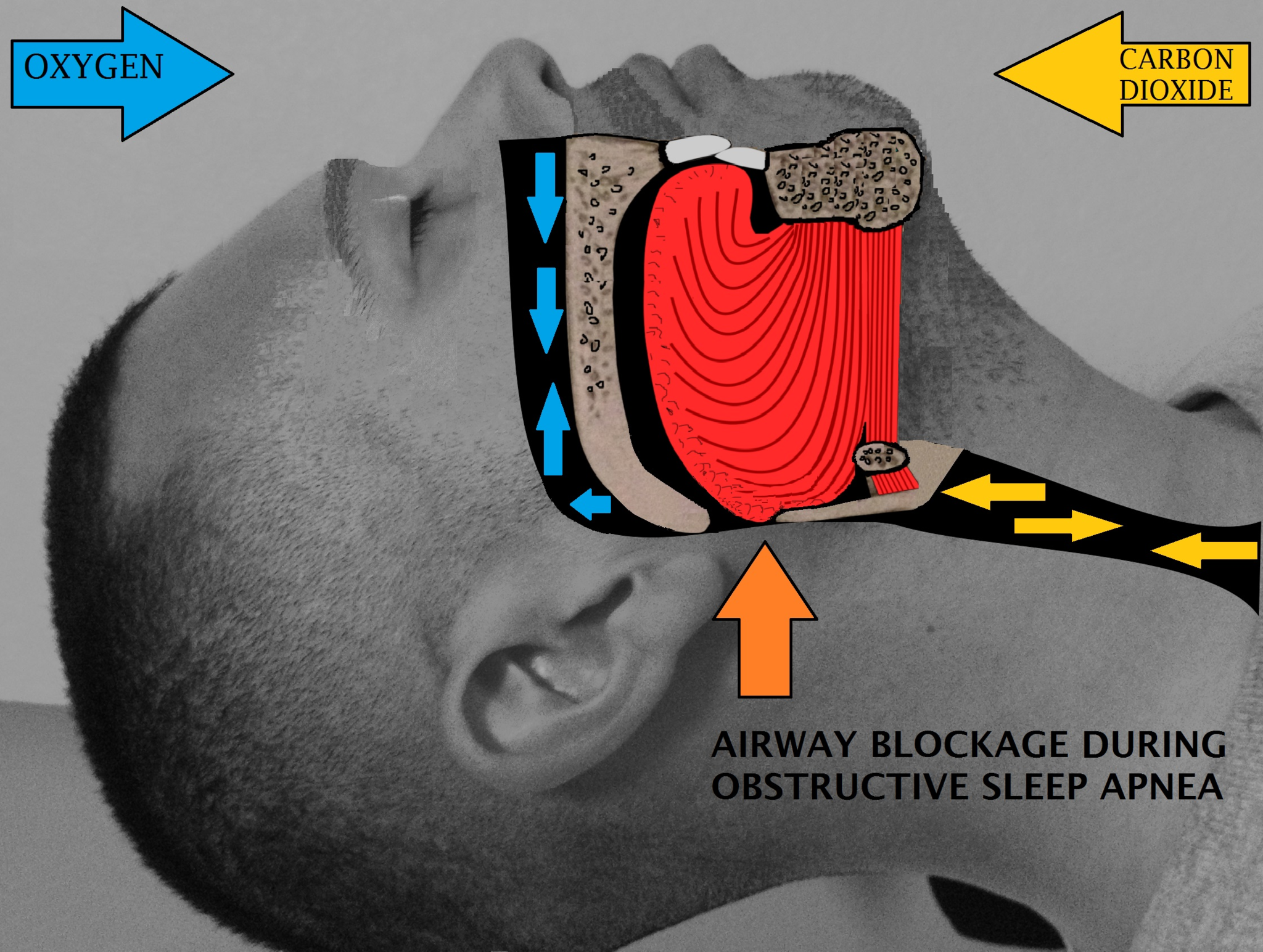
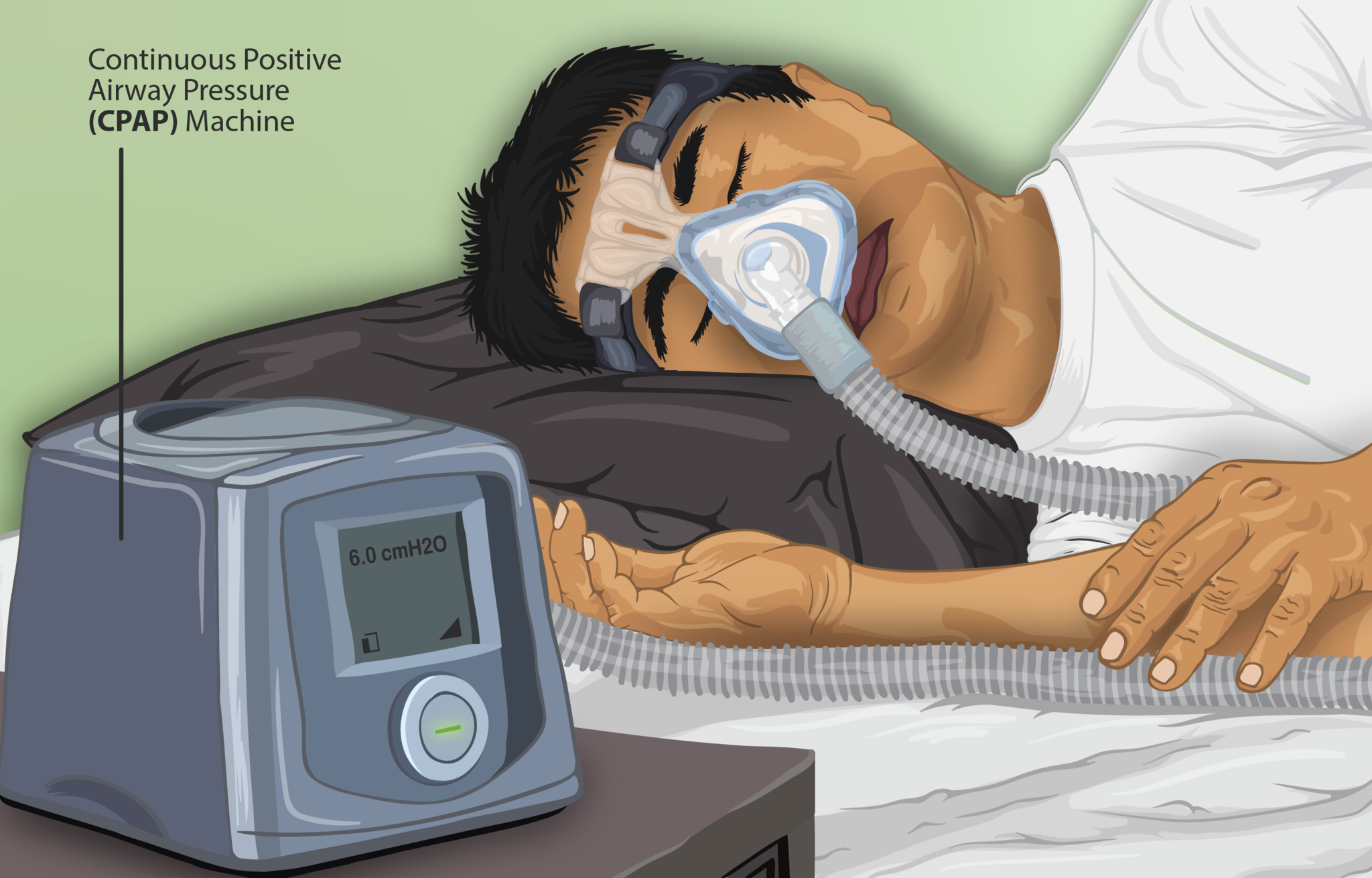
Treatment of sleep apnea may include avoiding alcohol, quitting smoking, or losing weight. Elevating the upper body during sleep or sleeping on one’s side may help prevent airway collapse in many people with sleep apnea. Another type of treatment is the use of an oral device that shifts the lower jaw forward to help keep the airway open during sleep. The most common treatment for moderate to severe sleep apnea is the use of CPAP (constant positive air pressure), which keeps the airway open by means of pressurized air during sleep. In this treatment, the person typically wears a plastic facial mask that is connected by a flexible tube to a small bedside CPAP machine as shown to the right in Figure 13.5.7. Although CPAP is effective, long-term compliance is often poor, because patients find the mask uncomfortable or they experience unpleasant side effects, such as dry mouth and nose. A more extreme form of treatment is surgery to remove some of the tissues — such as the tonsils or part of the soft palate — that tend to collapse and block the airway in people with sleep apnea.
13.5 Summary
- Asthma is a chronic inflammatory disease of the airways in the lungs, in which the airways periodically become inflamed. This causes swelling and narrowing of the airways, often with excessive mucus production, leading to difficulty breathing and other symptoms. Asthma is thought to be caused by a combination of genetic and environmental factors. Asthma attacks are triggered by allergens, air pollution, or other factors.
- Pneumonia is a common inflammatory disease of the respiratory tract, in which inflammation affects primarily the alveoli, which become filled with fluid that inhibits gas exchange. Most cases of pneumonia are caused by viral or bacterial infections. Vaccines are available to prevent pneumonia. Treatment often includes prescription antibiotics.
- Chronic obstructive pulmonary disease (COPD) is a lung disease characterized by chronic poor airflow, which causes shortness of breath and a productive cough. It is caused most often by tobacco smoking, which leads to breakdown of connective tissues in the lungs. Alveoli are reduced in number and elasticity, making it impossible to fully exhale air from the lungs. There is no cure for COPD, but stopping smoking may reduce the rate at which COPD worsens.
- Lung cancer is a malignant tumor characterized by uncontrolled cell growth in tissues of the lung. It results from accumulated DNA damage, most often caused by tobacco smoking. Lung cancer is typically diagnosed late, so most cases cannot be cured. It may be treated with surgery, chemotherapy, and/or radiation therapy.
13.5 Review Questions
-
- How can asthma attacks be prevented? How can symptoms of asthma attacks be controlled?.
- How can pneumonia be prevented? How is it treated?
- What is the difference between primary and secondary lung cancer? What is the major cause of primary lung cancer? Discuss lung cancer as a cause of death. How is lung cancer treated?
- What is the difference between how COPD and pneumonia affect the alveoli?
13.5 Explore More
https://www.youtube.com/watch?v=T2EmuyHoMAI&feature=emb_logo
Shaf Keshavjee at TEDMED 2010.
https://www.youtube.com/watch?v=rgphaHmAC_A&feature=emb_logo
Immunology of the Lung, Nature Video, 2014.
https://www.youtube.com/watch?v=W1rF2oFnfYI
What you should know about vaping and e-cigarettes, TEDMED, 2019.
https://www.youtube.com/watch?v=aQsOmGflf1o
What your breath could reveal about your health | Julian Burschka, TED, 2019.
Attributions
Figure 13.5.1
House_Dust_Mite by Employee of US Food and Drug Administration (archived) on Wikimedia Commons is in the public domain (https://en.wikipedia.org/wiki/Public_domain).
Figure 13.5.2
Asthma_attack-illustration_NIH by National Heart, Lung, Blood Institute/ U.S. National Institute of Health on Wikimedia Commons is in the public domain (https://en.wikipedia.org/wiki/Public_domain).
Figure 13.5.3
asthma-inhaler by Anthony Poynton on Public Domain Pictures is used under a CC0 1.0 Universal Public Domain Dedication License (https://creativecommons.org/publicdomain/zero/1.0/).
Figure 13.5.4
Lobar_pneumonia_illustrated by National Heart, Lung and Blood Institute / U.S. National Institute of Health on Wikimedia Commons is in the public domain (https://en.wikipedia.org/wiki/Public_domain).
Figure 13.5.5
Blausen_0343_Emphysema by Blausen Medical Communications, Inc. on Wikimedia Commons is used under a CC BY 3.0 (https://creativecommons.org/licenses/by/3.0) license.
Figure 13.5.6
Airway_obstruction by Drcamachoent on Wikimedia Commons is used under a CC BY-SA 4.0 (https://creativecommons.org/licenses/by-sa/4.0) license.
Figure 13.5.7
Depiction_of_a_Sleep_Apnea_patient_using_a_CPAP_machine by https://www.myupchar.com/en on Wikimedia Commons is used under a CC BY-SA 4.0 (https://creativecommons.org/licenses/by-sa/4.0) license.
References
Centers for Disease Control and Prevention (CDC). (2020). Travel: Pneumococcal disease (streptococcus pneumoniae) [online article]. U.S. Department of Health & Human Services. https://wwwnc.cdc.gov/travel/diseases/pneumococcal-disease-streptococcus-pneumoniae
Nature Video. (2014, December 15). Immunology of the lung. YouTube. https://www.youtube.com/watch?v=rgphaHmAC_A&feature=youtu.be
TED. (2019, February 25). What your breath could reveal about your health | Julian Burschka. YouTube. https://www.youtube.com/watch?v=aQsOmGflf1o&feature=youtu.be
TEDMED. (2010, December 7). Shaf Keshavjee at TEDMED 2010. YouTube. https://www.youtube.com/watch?v=T2EmuyHoMAI&feature=youtu.be
TEDMED. (2019, May 15). What you should know about vaping and e-cigarettes. YouTube. https://www.youtube.com/watch?v=W1rF2oFnfYI&feature=youtu.be
A thin, fibrous, extracellular matrix that separates the lining of an internal or external body surface from underlying connective tissue.
A thin, fibrous, extracellular matrix that separates the lining of an internal or external body surface from underlying connective tissue.
A highly selective membrane formed of epithelial cells that separates circulating blood from extracellular fluid in the brain and spinal cord.
A rigid organ that constitutes part of the vertebrate skeleton in animals.
A phenomenon in genetics in which the effect of a gene mutation is dependent on the presence or absence of mutations in one or more other genes, respectively termed modifier genes. In other words, the effect of the mutation is dependent on the genetic background in which it appears.
Created by CK-12 Foundation/Adapted by Christine Miller

Sure Death
This anti-smoking photo (Figure 13.6.1) clearly makes the point that smoking causes death. The image is not using hyperbole, because smoking actually is deadly. It causes about 7 million deaths each year, and is the single greatest cause of preventable death worldwide. As many as half of all people who smoke tobacco die from it. As a result of smoking’s deadly effects, the life expectancy of long-term smokers is significantly less than that of non-smokers. In fact, long-term smokers can expect their lifespan to be reduced by as much as 18 years, and they are three times more likely than non-smokers to die before the age of 70.
Why Is Smoking Deadly?
As shown in Figure 13.6.2, tobacco smoking has adverse effects on just about every bodily system and organ. The detrimental health effects of smoking depend on the number of years that a person smokes and how much the person smokes. Contrary to popular belief, all forms of tobacco smoke — including smoke from cigars and tobacco pipes — have similar health risks as those of cigarette smoke. Smokeless tobacco may be less of a danger to the lungs and heart, but it, too, has serious health effects. It significantly increases the risk of cancers of the mouth and throat, among other health problems.

Even non-smokers may not be spared the deadly risks of tobacco smoke. If you spend time around smokers either at home or on the job, then you are at risk of the dangers of secondhand smoke. Secondhand smoke enters the air directly from burning cigarettes (and cigars and pipes), and indirectly from smokers' lungs. This smoke may linger in indoor air for hours, and it increases the risk of a wide range of adverse health effects. According to Health Canada, second-hand smoke causes 800 deaths from lung cancer and heart disease in non-smokers every year. The 2014 U.S. Surgeon General’s Report concluded that there is no established risk-free level of exposure to secondhand smoke. Non-smokers who are exposed to secondhand smoke may have as much as a 30 per cent increase in their risk of lung cancer and heart disease.
Tobacco contains nicotine, which is a psychoactive drug. Although nicotine in tobacco smoke does not directly cause cancer or most of the other health risks of smoking, it is a highly addictive drug. Nicotine is actually even more addictive than cocaine or heroin. The addictive nature of nicotine explains why it is so difficult for smokers to quit the habit, even when they know the health risks and really want to stop smoking. The good news is that if someone does stop smoking, his or her risks of smoking-related diseases and death soon start to fall. By one year after quitting, the risk of heart disease drops to only half of that of a continuing smoker.
Smoking and Cancer
One of the main health risks of smoking is cancer, particular cancer of the lung. Because of the increased risk of lung cancer with smoking, the risk of dying from lung cancer before age 85 is more than 20 times higher for a male smoker than for a male non-smoker. As the rate of smoking increases, so does the rate of lung cancer deaths, although the effects of smoking on lung cancer deaths can take up to 20 years to manifest themselves, as shown in Figure 13.6.3. Besides lung cancer, several other forms of cancer are also significantly more likely in smokers than non-smokers, including cancers of the kidney, larynx, mouth, lip, tongue, throat, bladder, esophagus, pancreas, and stomach. Unfortunately, many of these cancers have extremely low cure rates.
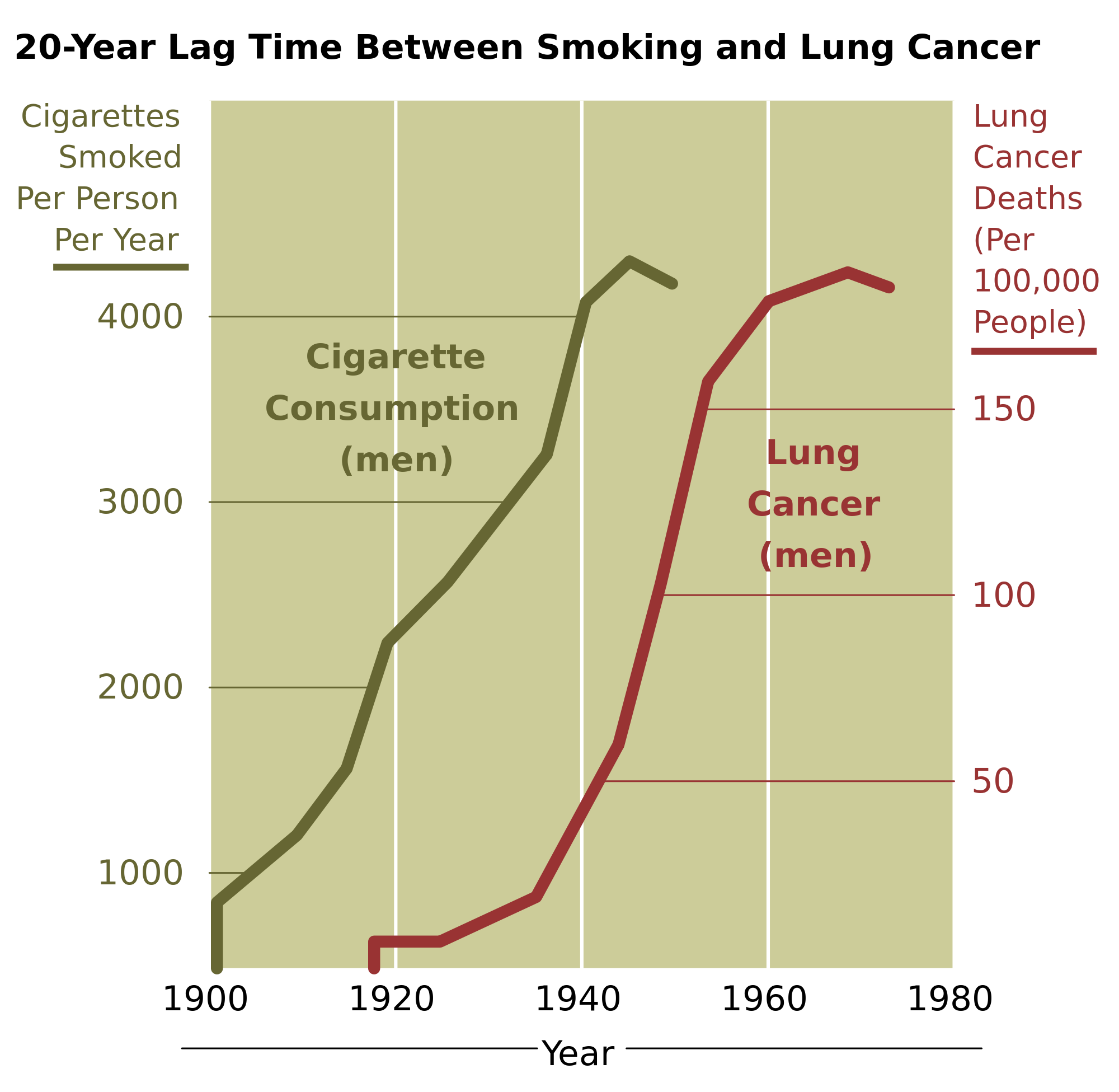
When you consider the composition of tobacco smoke, it’s not surprising that it increases the risk of cancer. Tobacco smoke contains dozens of chemicals proven to be carcinogens, or causes of cancer. Many of these chemicals bind to DNA in a smoker’s cells, and may either kill the cells or cause mutations. If the mutations inhibit programmed cell death, the cells can survive to become cancer cells. Some of the most potent carcinogens in tobacco smoke include benzopyrene, acrolein, and nitrosamines. Other carcinogens in tobacco smoke are radioactive isotopes, including lead-210 and polonium-210.
Respiratory Effects of Smoking
Long-term exposure to the compounds found in cigarette smoke — such as carbon monoxide and cyanide — are thought to be responsible for much of the lung damage caused by smoking. These chemicals reduce the elasticity of alveoli, leading to chronic obstructive pulmonary disease (COPD). COPD is a permanent, incurable, and often fatal reduction in the capacity of the lungs, reducing the lungs' ability to fully exhale air. The chronic inflammation that is also present in COPD is exacerbated by the tobacco smoke carcinogen acrolein and its derivatives. COPD is almost completely preventable simply by not smoking and by also avoiding secondhand smoke.
Cardiovascular Effects of Smoking
Inhalation of tobacco smoke causes several immediate responses in the heart and blood vessels. Within one minute of inhalation of smoke, the heart rate begins to rise, increasing by as much as 30 per cent during the first ten minutes of smoking. Carbon monoxide in tobacco smoke binds with hemoglobin in red blood cells, thereby reducing the blood’s ability to carry oxygen. Hemoglobin bound to carbon monoxide forms such a stable complex that it may result in a permanent loss of red blood cell function. Several other chemicals in tobacco smoke lead to narrowing and weakening of blood vessels, as well as an increase in substances that contribute to blood clotting. These changes increase blood pressure and the chances of a blood clot forming and blocking a vessel, thereby elevating the risk of heart attack and stroke. A recent study found that smokers are five times more likely than non-smokers to have a heart attack before the age of 40.
Smoking has also been shown to have a negative impact on levels of blood lipids. Total cholesterol levels tend to be higher in smokers than non-smokers. Ratios of “good” cholesterol to “bad” cholesterol tend to be lower in smokers than non-smokers.
Additional Adverse Health Effects of Smoking
A wide diversity of additional adverse health effects are attributable to smoking. Here are just a few of them:
- Smokers are at significantly increased risk of developing chronic kidney disease (in addition to kidney cancer). For example, smoking hastens the progression of kidney damage in people with diabetes.
- People who smoke — especially the elderly — have a greater risk of influenza and other infectious diseases than non-smokers. Smoking more than 20 cigarettes a day has been found to increase the risk of infectious diseases by as much as four times the risk in non-smokers. These effects occur because of damage to both the respiratory system and the immune system.
- In addition to oral cancer, smoking causes other oral problems, including periodontitis (gum disease). Roughly half of the cases of gum inflammation are attributable to current or former smoking. This inflammation increases the risk of tooth loss, which is also higher in smokers than non-smokers. In addition, smoking stains the teeth and causes halitosis (bad breath).
- Smoking is a key cause of erectile dysfunction (ED), probably because it leads to narrowing of arteries in the penis, as it does elsewhere in the body. The incidence of ED is about 85 per cent higher in males who smoke than it is in non-smokers.
- Smoking also has adverse effects on the female reproductive system, potentially causing infertility, in part because it interferes with the body’s ability to produce estrogen. Female smokers are about 60 per cent more likely to be infertile than non-smokers. Pregnant women who smoke or are exposed to secondhand smoke have a higher risk of miscarriages and low-birth-weight infants.
- Certain therapeutic drugs, including some antidepressants and anticonvulsants, are less effective in smokers than in non-smokers. This occurs because smoking increases levels of liver enzymes that break down the drugs.
- Smoking causes an estimated ten per cent of all fire-related deaths worldwide. Smokers are also at a greater risk of dying in motor vehicle crashes and other accidents.
- Smoking leads to an increased risk of bone fractures, especially of the hip. It also leads to slower wound healing after surgery, and an increased rate of postoperative complications.
Feature: Human Biology in the News
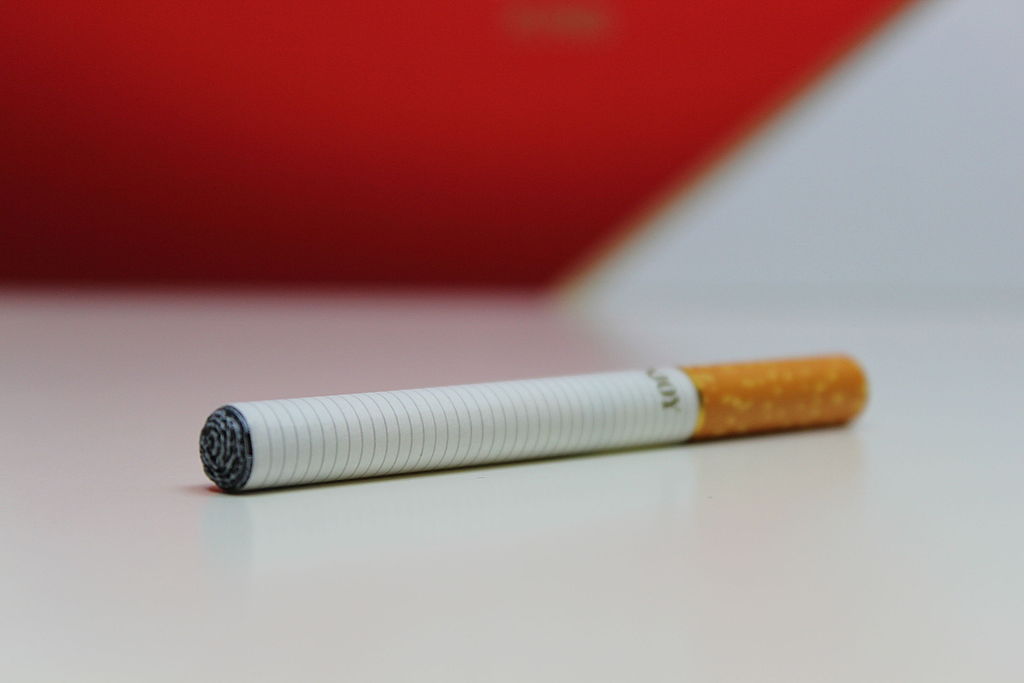
The item in Figure 13.6.4 looks like a regular cigarette, but it’s actually an electronic cigarette, or e-cigarette. E-cigarettes are battery-powered devices that change flavored liquids and nicotine into vapor that the user inhales. E-cigarettes are often promoted as being safer than traditional tobacco products, and their use is touted as a good way to quit smoking. They are often not banned in smoke-free areas, where it is illegal to smoke tobacco cigarettes.
A study completed in 2015 by researchers at the Harvard School of Public Health and widely reported in the mass media found that e-cigarettes may, in fact, be very harmful to the user’s health. E-cigarettes contain nicotine and cancer-causing chemicals, such as formaldehyde. According to the study, about three-quarters of flavored e-cigarettes also contain a chemical called diacetyl that causes an incurable and potentially fatal disorder of the lungs, commonly called “popcorn lung” (bronchiolitis obliterans). In this disorder, the bronchioles compress and narrow due to the formation of scar tissue, greatly diminishing the breathing capacity of people with the disorder. Popcorn lung gained its common name in 2004, when it was diagnosed in workers at popcorn factories. The buttery flavoring used in the factories contained diacetyl.
Some manufacturers of e-cigarettes and flavorings advertise that their products are now free of diacetyl. However, because e-cigarettes are not currently regulated by the FDA, there is no way of knowing for sure whether the products are actually safe. Equally disturbing is the appeal of flavored e-cigarettes to teens and producers' attempts to specifically market their products to this age group. Flavors such as “cotton candy,” “Katy Perry’s cherry,” and “alien blood” are obviously marketed to youth. Not surprisingly, the use of e-cigarettes is on the rise in middle and high school students, who are more likely to use them than regular cigarettes. Public health officials fear that e-cigarettes will be a gateway for teens to move on to smoking tobacco cigarettes. Some U.S. states have recently passed laws prohibiting minors from buying e-cigarettes, and Brazil, Singapore, Uruguay, and India have banned e-cigarettes. E-cigarettes were not initially regulated by Health Canada because they don't contain nicotine, which made them illegal to sell, but this was not widely enforced. However, Canada enacted the Tobacco and Vaping Products Act (TVPA) on May 23, 2018. As more questions are raised about their potential negative health effects, it is likely that more laws will be passed to regulate e-cigarettes. Watch the news for updates on this issue.
13.6 Summary
- Smoking is the single greatest cause of preventable death worldwide. It has adverse effects on just about every body system and organ. Tobacco smoke affects not only smokers, but also non-smokers who are exposed to secondhand smoke. The nicotine in tobacco is highly addictive, making it very difficult to quit smoking.
- A major health risk of smoking is cancer of the lungs. Smoking also increases the risk of many other types of cancer. Tobacco smoke contains dozens of chemicals known as carcinogens.
- Smoking is the primary cause of chronic obstructive pulmonary disease (COPD). Chemicals such as carbon monoxide and cyanide in tobacco smoke reduce the elasticity of alveoli so the lungs can no longer fully exhale air.
- Smoking damages the cardiovascular system and increases the risk of high blood pressure, blood clots, heart attack, and stroke. Smoking also has a negative impact on levels of blood lipids.
- A wide diversity of additional adverse health effects are attributable to smoking, such as erectile dysfunction, female infertility, and slow wound healing.
13.6 Review Questions
- Create a pamphlet aimed at informing teenagers about the dangers of smoking. Include information about numbers of deaths associated with smoking, life expectancy of smokers, and long term healthy effects of smoking and exposure to second-hand smoke. Include a section on the chemicals present in tobacco smoke and e-cigarettes and some of the adverse affects associated with these chemicals.
- What smoking-related factors determine how smoking affects a smoker’s health?
- What are the two sources of secondhand cigarette smoke? How does exposure to secondhand smoke affect non-smokers?
- Why is it so difficult for smokers to quit the habit? How is their health likely to be affected by quitting?
- Why does smoking cause cancer? List five types of cancer that are significantly more likely in smokers than non-smokers.
- Explain how smoking causes COPD.
- Do you think e-cigarettes can be addictive? Explain your reasoning.
13.6 Explore More
https://www.youtube.com/watch?v=lgVvnnnawvw&feature=emb_logo
Blowing Smoke: The Lost Legacy of the Surgeon General's Report | Alan Blum | TEDxTuscaloosa, TEDx Talks, 2015.
https://www.youtube.com/watch?v=QL2-EsjfiAU
The dangers of vaping, RWJ Barnabas Health, 2019.
Attributions
Figure 13.6.1
Cigarette by Uitbundig on Unsplash is used under the Unsplash License (https://unsplash.com/license)
Figure 13.6.2
Risks_from_smoking-smoking_can_damage_every_part_of_the_body by CDC on Wikimedia Commons is in the public domain (https://en.wikipedia.org/wiki/Public_domain).
Figure 13.6.3
Cancer_smoking_lung_cancer_correlation_from_NIH.svg by Sakurambo on Wikimedia Commons is in the public domain (https://en.wikipedia.org/wiki/Public_domain).
Figure 13.6.4
An_Electronic_Cigarette_(11359245033) by Lindsay Fox from Newport beach, United States on Wikimedia Commons is used under a CC BY 2.0 (https://creativecommons.org/licenses/by/2.0) license.
References
Allen, J. G., Flanigan, S. S., LeBlanc, M., Vallarino, J., MacNaughton, P., Stewart, J. H., Christiani, D.C. (2016, June 1). Flavoring chemicals in E-Cigarettes: Diacetyl, 2,3-Pentanedione, and Acetoin in a sample of 51 products, including fruit-, candy-, and cocktail-flavored E-cigarettes [online article]. Environmental Health Perspectives, 124:733–739. https://doi.org/10.1289/ehp.1510185
Health Canada. (2015). Dangers of second-hand smoke [online article]. Government of Canada. https://www.canada.ca/en/health-canada/services/smoking-tobacco/avoid-second-hand-smoke/second-hand-smoke/dangers-second-hand-smoke.html
RWJ Barnabas Health. (2019, September 25). The dangers of vaping. YouTube. https://www.youtube.com/watch?v=QL2-EsjfiAU&feature=youtu.be
TEDx Talks. (2015, August 7). Blowing smoke: The lost legacy of the surgeon general's report | Alan Blum | TEDxTuscaloosa. https://www.youtube.com/watch?v=lgVvnnnawvw&feature=youtu.be
Tobacco and Vaping Products Act. (2016, June 26). Government of Canada. https://www.canada.ca/en/health-canada/services/health-concerns/tobacco/legislation/federal-laws/tobacco-act.html
Vaping, E-cigarettes to be regulated by Health Canada. (2016, November 22). CBC/Radio-Canada. HTTP://www.cbc.ca/news/health/vaping-health-canada-legislation-1.3862589
Wikipedia contributors. (2020, August 9). Regulation of electronic cigarettes. In Wikipedia. https://en.wikipedia.org/w/index.php?title=Regulation_of_electronic_cigarettes&oldid=972059825
Image shows a photograph of a humidifier emitting mist.
Image shows a comparison of healthy bronchial tubes and bronchial tubes with bronchitis. The tubes with bronchitis have inflamed walls and increased amounts of mucous, substantially decreasing the pathway for air.
A class of molecules that includes the non-steroid hormones produced by the medulla of the adrenal gland, such as adrenaline, that stimulate the fight-or-flight response.
The part of the brain below the cerebrum and behind the brain stem that coordinates body movements.
The highly folded, thin outer layer of the cerebrum where most information processing in the brain takes place.
Image shows a drawing of the cardiovascular system. The diagram includes the heart, all veins are in blue and all arteries are in red. Diagram shows the major arteries and veins in the head, neck, arms, legs and torso.
Clear fluid produced by the brain that forms a thin layer within the meninges and provides protection and cushioning for the brain and spinal cord.
A coiled, fluid-filled tube in the inner ear that changes mechanical sound vibrations and positional information to nerve impulses that travel to the brain.
Component of a homeostatic control mechanism that monitors a variable and sends signals to the effector as needed to keep the variable in homeostasis.

